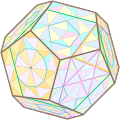Category:Golden tilings on Platonic dodecahedron
Jump to navigation
Jump to search
English:
Each of these images shows one or more projections of Platonic dodecahedron having at least a face entirely or partially tiled by golden triangles. Here a tiling called “golden tiling” will be an edge‑to‑edge tiling by golden triangles, where any boundary between two adjacent elements is a full edge of one and the other element. For us a golden triangle can be either obtuse-angled with two 36 degrees angles, or isosceles again but having only one 36 degrees angle.
Each of these images shows one or more projections of Platonic dodecahedron having at least a face entirely or partially tiled by golden triangles. Here a tiling called “golden tiling” will be an edge‑to‑edge tiling by golden triangles, where any boundary between two adjacent elements is a full edge of one and the other element. For us a golden triangle can be either obtuse-angled with two 36 degrees angles, or isosceles again but having only one 36 degrees angle.
Here all projections of convex regular dodecahedron will be orthogonal, in other words the projection directions will be perpendicular to the image plane. An orthogonal projection of such a dodecahedron shows necessarily four or six of its twelve faces.
Français :
Chacune de ces images montre une ou plusieurs projections d’un dodécaèdre de Platon, ayant au moins une face pavée de triangles d’or, entièrement ou en partie. Ici est appelé “pavage d’or” un pavage bord à bord de triangles d’or, où toute frontière entre deux éléments adjacents est un côté complet de l’un et l’autre élément. Pour nous un triangle d’or est un triangle isocèle soit acutangle avec un seul angle de 36 degrés, soit non acutangle avec deux angles de 36 degrés. Ici les projections du dodécaèdre régulier convexe seront toutes orthogonales, autrement dit les directions de projection seront perpendiculaires au plan de l’image. Une projection orthogonale d’un tel dodécaèdre montre nécessairement quatre ou six de ses douze faces.
Chacune de ces images montre une ou plusieurs projections d’un dodécaèdre de Platon, ayant au moins une face pavée de triangles d’or, entièrement ou en partie. Ici est appelé “pavage d’or” un pavage bord à bord de triangles d’or, où toute frontière entre deux éléments adjacents est un côté complet de l’un et l’autre élément. Pour nous un triangle d’or est un triangle isocèle soit acutangle avec un seul angle de 36 degrés, soit non acutangle avec deux angles de 36 degrés. Ici les projections du dodécaèdre régulier convexe seront toutes orthogonales, autrement dit les directions de projection seront perpendiculaires au plan de l’image. Une projection orthogonale d’un tel dodécaèdre montre nécessairement quatre ou six de ses douze faces.
Media in category "Golden tilings on Platonic dodecahedron"
The following 9 files are in this category, out of 9 total.
-
Golden number and Platonic dodecahedron exhibited through golden tilings.svg 1,131 × 699; 19 KB
-
Golden ratio in regular dodecahedron (upper-case phi).svg 780 × 780; 7 KB
-
Golden ratio in regular dodecahedron, extended (upper-case phi).svg 1,200 × 750; 10 KB
-
Golden ratio in regular dodecahedron, extended.svg 1,200 × 750; 10 KB
-
Golden ratio in regular dodecahedron.svg 780 × 780; 7 KB








